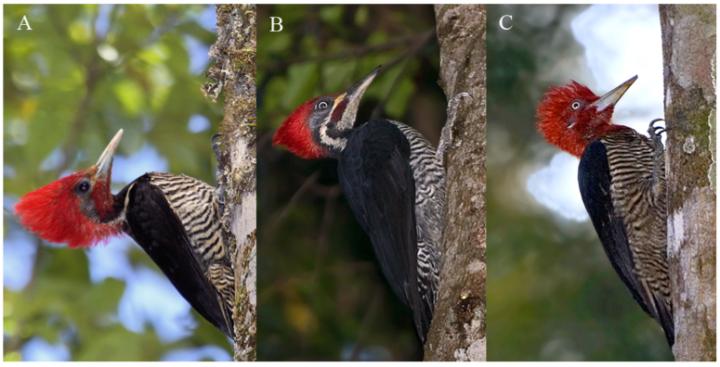- Through genetics, scientists have discovered that the helmeted woodpecker is not closely related to similar species – despite looking a lot like them.
- The researchers say it evolved similar markings to compete with these bigger, more aggressive woodpeckers.
- The helmeted woodpecker is a threatened species and lives in the Atlantic Forest, one of the most imperiled ecosystems on the planet.
Being a little woodpecker in a world of big woodpeckers isn’t easy. You lose out on the best nest sites, and you get chased off the trees with the best grubs. But one little woodpecker has found a way to survive amidst its bigger rivals. It’s evolved a look that fools the other woodpeckers into thinking it’s one of them, according to new research published recently in The Auk: Ornithological Advances.
The helmeted woodpecker (née Dryocopus galeatus) lives in South America’s Atlantic Forest, and shares its habitat with lineated (D. lineatus) and robust (Campephilus robustus) woodpeckers, which are each more than twice the size of little galeatus. But what it lacks in size, the helmeted woodpecker makes up for in style, sharing the red head, black back, and barred breast of the other species. The researchers say its similar markings has allowed it to persist alongside the bigger woodpeckers.
“Because of this, it has the advantage of foraging in the same areas as the birds it’s mimicking, with those birds not being aggressive to this smaller woodpecker,” said Mark Robbins, ornithology collection manager with the University of Kansas Biodiversity Institute.

Through the years the helmeted woodpecker has fooled ornithologists, too.
“It’s very similar in pattern to these other woodpeckers,” Robbins said. “In the 1980s, a monograph called ‘Woodpeckers of the World’ used museum specimens to assume relationships, and that has misled ornithologists across the board. Looking only at plumage has misguided us again and again.”
Then, at an ornithology conference in Sao Paulo in 2010, Robbins had an experience that led him to take a deeper look at the species.
“Some friends and I went off to see Brazilian birds in Atlantic Forest, and we really wanted to see helmeted woodpecker,” he said. “One morning everyone was eating breakfast, but I was out by a lagoon. I heard its call, and went flying back inside through the doors saying, “There’s a Helmeted Woodpecker!” So there was mass rush out the doors, and we spent over an hour following this woodpecker. I was thinking, ‘I don’t think this is a Dryocopus‘ — and later thought it might be a member of [another] woodpecker genus.”
And so Robbins, along with Brett Benz of the American Museum of Natural History and Kevin Zimmer of the Los Angeles County Museum, decided to check out the genetics of the helmeted woodpecker and determine just how related it was to the other two species.
Their results showed that it is only distantly related to its once-assumed genus mate, the lineated woodpecker. Because of this, the researchers recommend moving the helmeted woodpecker from the Dryocopus genus to Celeus.
But even though the helmeted woodpecker looks like the other species in pattern, wouldn’t its comparatively tiny size give the game away? Not so, say the scientists, writing that “estimates of avian visual acuity suggest that size-related mimetic deception is plausible at distances ecologically relevant to Celeus and Dryocopus foraging behavior.” In other words, the woodpeckers usually hang out far enough away from each other that they can’t discern the size difference.
Moreover, the woodpecker’s small size and timid nature are consistent with the predictions of evolutionary models that describe how competition and natural selection may play out.
The helmeted woodpecker lives in the highly threatened and degraded Atlantic Forest or Mata Atlântica, an ecosystem that stretches – well, once stretched – along much of Brazil’s coast and inland to Paraguay. Regarded as the world’s most imperiled biodiversity hotspot, only 6 to 10 percent of its original forest left, the rest cleared largely for agricultural purposes. Some scientists say that only 3.5 percent may remain. Clinging to these remnants are many endemic species found nowhere else in the world – including the helmeted woodpecker, which is listed as Vulnerable by the IUCN.

“It’s only found in southeastern Brazil, eastern Paraguay and extreme northern Argentina,” Robbins said. “Much of that forest is gone. It’s a biome that’s been particularly degraded, and this woodpecker had declined considerably due to deforestation of the Atlantic Forests.”
According to Robbins, soybean and sunflower farming have made some parts of the helmeted woodpecker’s range uninhabitable.
“There are some places in eastern Paraguay where this bird once lived in Atlantic Forest where now it looks more like Kansas,” Robbins said.
Citation
- Benz, B. W., Robbins, M. B., & Zimmer, K. J. (2015). Phylogenetic relationships of the Helmeted Woodpecker (Dryocopus galeatus): A case of interspecific mimicry?. bioRxiv, 023663.
